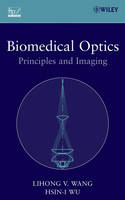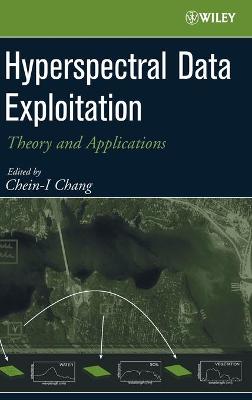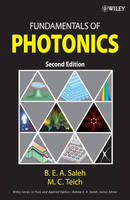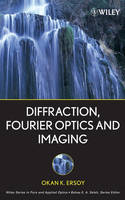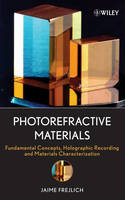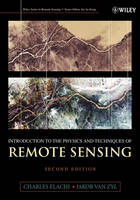Optical Signal Processing
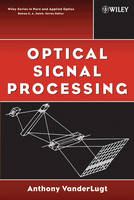 -15%
portes grátis
-15%
portes grátis
Optical Signal Processing
VanderLugt, Anthony
John Wiley & Sons Inc
07/2005
632
Mole
Inglês
9780471745327
15 a 20 dias
960
Descrição não disponível.
Chapter 1. Basic Signal Parameters. 1.1 Introduction.
1.2 Characterization of a General Signal.
1.3 The Sample Function.
1.4 Examples of Signals.
1.5 Spatial Signals.
Chapter 2. Geometrical Optics.
2.1 Introduction.
2.2 Refractive Index and Optical Path.
2.3 Basic Laws of Geometrical Optics.
2.4 Refraction by Prisms.
2.5 The Lens Formulas.
2.6 The General Imaging Condition.
2.7 The Optical Invariant.
2.8 Classification of Lenses and Systems.
2.9 Aberrations.
Chapter 3. Physical Optics.
3.1 Introduction.
3.2 The Fresnel Transform.
3.3 The Fourier Transform.
3.4 Examples of Fourier Transforms.
3.5 The Inverse Fourier Transform.
3.6 Extended Fourier-Transform Analysis.
3.7 Maximum Information Capacity and Optimum.
3.8 System Coherence.
Chapter 4. Spectrum Analysis.
4.1 Introduction.
4.2 Light Sources.
4.3 Spatial Light Modulators.
4.4 The Detection Process in the Fourier Domain.
4.5 System Performance Parameters.
4.6 Dynamic Range.
4.7 Raster-Format Spectrum Analyzer.
4.8 Summary of the Main Design Concepts.
Chapter 5. Spatial Filtering.
5.1 Introduction.
5.2 Some Fundamentals of Signal Processing.
5.3 Spatial Filters.
5.4 Binary Spatial Filters.
5.5 Magnitude Spatial Filters.
5.6 Phase Spatial Filters.
5.7 Real-Valued Spatial Filters.
5.8 Experimental Examples.
5.9 The Spatial Carrier Frequency Filter.
5.10 Interferometric Methods for Constructing Filters.
5.11 Information Processing.
5.12 Arbitrary Reference Function.
5.13 Bandwidth Considerations.
5.14 Multiplexed Filters.
5.15 Computer Generated Filters.
5.16 Reference Function Optical Processors.
Chapter 6. Spatial Filtering Systems.
6.1 Introduction.
6.2 Optical Signal Processor and Filter Generator.
6.3 The Readout Module.
6.4 The Reference-to-Signal-Beam Ratio.
6.5 Orientation and Scale-Searching Operations.
6.6 Methods for Handling Nonuniform Noise Spectral Densities.
6.7 Other Applications for Optical Spatial Filtering.
6.8 The Effects of Small Displacements of Spatial Filters.
Chapter 7. Acousto-Optic Devices.
7.1 Introduction.
7.2 Acousto-Optic Cell Spatial Light Modulators.
7.3 Dynamic Transfer Relationships.
7.4 Time Delays and Notation.
7.5 Phase-Modulation Notation.
7.6 Sign Notation.
7.7 Conjugate Relationships.
7.8 Visualization of the Acousto-Optic Interaction.
7.9 Applications of Acousto-Optic Devices.
Chapter 8. Acousto-Optic Power Spectrum Analyzers.
8.1 Introduction.
8.2 A Basic Spectrum Analyzer.
8.3 Aperture Weighting for Sidelobe Control.
8.4 Resolution.
8.5 Dynamic Range and Signal-to-Noise Ratio.
8.6 Spur-Free Dynamic Range.
8.7 Photodetector Geometric Considerations.
8.8 Example.
8.9 The Signal-to-Noise Ratio.
8.10 Radiometers.
8.11 Summary of the Main Design Concepts.
Chapter 9. Heterodyne Systems.
9.1 Introduction.
9.2 The Interference Between Two Waves.
9.3 Overlapping Waves and Photodetector Size.
9.4 The Optical Radio.
9.5 A Generalized Heterodyne System.
Chapter 10. Heterodyne Spectrum Analysis.
10.1 Introduction.
10.2 Basic Theory.
10.3 Spatial and Temporal Frequencies: The Mixed Transform.
10.4 The Distributed Local Oscillator.
10.5 Photodetector Geometry and Bandwidth.
10.6 Temporal Frequencies of the Reference Bias Term.
10.7 Dynamic Range.
10.8 Comparison of the Heterodyne and Power Spectrum.
10.9 Hybrid Heterodyne Spectrum Analyzer.
Chapter 11. Decimated Arrays and Cross-Spectrum Analysis.
11.1 Introduction.
11.2 Background for the Heterodyne Spectrum Analyzer.
11.3 Photodetector Geometry and Detection Scheme.
11.4 The Reference and Scanning Functions.
11.5 Signal-to-Noise Radio and Dynamic Range.
11.6 Improved Reference Waveform.
11.7 The Cross-Spectrum Analyzer.
Chapter 12. The Heterodyne Transform and Signal Excision.
12.1 Introduction.
12.2 The Heterodyne Transform.
12.3 The Temporal Frequency Range of the Baseband Terms.
12.4 Probing Arbitrary Three-Dimensional Fields.
12.5 Signal Excision.
12.6 Arbitrary Filter Function.
Chapter 13. Space-Integrating Correlators.
13.1 Introduction.
13.2 Reference-Function Correlators.
13.3 Multichannel Operation.
13.4 Heterodyne/Homodyne Detection.
13.5 Homodyne Detection in the Fourier Domain.
13.6 Heterodyne Detection.
13.7 Carrier Frequency Requirements.
13.8 Illumination Requirements.
13.9 Integrate and Dump.
13.10 Some More Configurations.
Chapter 14. Time-Integrating Systems.
14.1 Introduction.
14.2 Spectrum Analysis.
14.3 Time-Integrating Correlation.
14.4 Electronic Reference Correlator.
14.5 Comparison of Features.
14.6 Integrated Optical Systems.
Chapter 15. Two-Dimensional Processing.
15.1 Introduction.
15.2 Triple-Product Processing.
15.3 Crossed Acousto-Optic Cell Geometry.
15.4 The Bispectrum.
15.5 Spectrum Analysis.
15.6 Ambiguity Function Generation.
15.7 Wigner-Ville Distributions.
15.8 Range and Doppler Signal Processing.
15.9 Optical Transversal Processor for Notch Filtering.
15.10 Phased Array Processing.
Appendix I.
Appendix II.
References.
Bibliography.
Index.
1.2 Characterization of a General Signal.
1.3 The Sample Function.
1.4 Examples of Signals.
1.5 Spatial Signals.
Chapter 2. Geometrical Optics.
2.1 Introduction.
2.2 Refractive Index and Optical Path.
2.3 Basic Laws of Geometrical Optics.
2.4 Refraction by Prisms.
2.5 The Lens Formulas.
2.6 The General Imaging Condition.
2.7 The Optical Invariant.
2.8 Classification of Lenses and Systems.
2.9 Aberrations.
Chapter 3. Physical Optics.
3.1 Introduction.
3.2 The Fresnel Transform.
3.3 The Fourier Transform.
3.4 Examples of Fourier Transforms.
3.5 The Inverse Fourier Transform.
3.6 Extended Fourier-Transform Analysis.
3.7 Maximum Information Capacity and Optimum.
3.8 System Coherence.
Chapter 4. Spectrum Analysis.
4.1 Introduction.
4.2 Light Sources.
4.3 Spatial Light Modulators.
4.4 The Detection Process in the Fourier Domain.
4.5 System Performance Parameters.
4.6 Dynamic Range.
4.7 Raster-Format Spectrum Analyzer.
4.8 Summary of the Main Design Concepts.
Chapter 5. Spatial Filtering.
5.1 Introduction.
5.2 Some Fundamentals of Signal Processing.
5.3 Spatial Filters.
5.4 Binary Spatial Filters.
5.5 Magnitude Spatial Filters.
5.6 Phase Spatial Filters.
5.7 Real-Valued Spatial Filters.
5.8 Experimental Examples.
5.9 The Spatial Carrier Frequency Filter.
5.10 Interferometric Methods for Constructing Filters.
5.11 Information Processing.
5.12 Arbitrary Reference Function.
5.13 Bandwidth Considerations.
5.14 Multiplexed Filters.
5.15 Computer Generated Filters.
5.16 Reference Function Optical Processors.
Chapter 6. Spatial Filtering Systems.
6.1 Introduction.
6.2 Optical Signal Processor and Filter Generator.
6.3 The Readout Module.
6.4 The Reference-to-Signal-Beam Ratio.
6.5 Orientation and Scale-Searching Operations.
6.6 Methods for Handling Nonuniform Noise Spectral Densities.
6.7 Other Applications for Optical Spatial Filtering.
6.8 The Effects of Small Displacements of Spatial Filters.
Chapter 7. Acousto-Optic Devices.
7.1 Introduction.
7.2 Acousto-Optic Cell Spatial Light Modulators.
7.3 Dynamic Transfer Relationships.
7.4 Time Delays and Notation.
7.5 Phase-Modulation Notation.
7.6 Sign Notation.
7.7 Conjugate Relationships.
7.8 Visualization of the Acousto-Optic Interaction.
7.9 Applications of Acousto-Optic Devices.
Chapter 8. Acousto-Optic Power Spectrum Analyzers.
8.1 Introduction.
8.2 A Basic Spectrum Analyzer.
8.3 Aperture Weighting for Sidelobe Control.
8.4 Resolution.
8.5 Dynamic Range and Signal-to-Noise Ratio.
8.6 Spur-Free Dynamic Range.
8.7 Photodetector Geometric Considerations.
8.8 Example.
8.9 The Signal-to-Noise Ratio.
8.10 Radiometers.
8.11 Summary of the Main Design Concepts.
Chapter 9. Heterodyne Systems.
9.1 Introduction.
9.2 The Interference Between Two Waves.
9.3 Overlapping Waves and Photodetector Size.
9.4 The Optical Radio.
9.5 A Generalized Heterodyne System.
Chapter 10. Heterodyne Spectrum Analysis.
10.1 Introduction.
10.2 Basic Theory.
10.3 Spatial and Temporal Frequencies: The Mixed Transform.
10.4 The Distributed Local Oscillator.
10.5 Photodetector Geometry and Bandwidth.
10.6 Temporal Frequencies of the Reference Bias Term.
10.7 Dynamic Range.
10.8 Comparison of the Heterodyne and Power Spectrum.
10.9 Hybrid Heterodyne Spectrum Analyzer.
Chapter 11. Decimated Arrays and Cross-Spectrum Analysis.
11.1 Introduction.
11.2 Background for the Heterodyne Spectrum Analyzer.
11.3 Photodetector Geometry and Detection Scheme.
11.4 The Reference and Scanning Functions.
11.5 Signal-to-Noise Radio and Dynamic Range.
11.6 Improved Reference Waveform.
11.7 The Cross-Spectrum Analyzer.
Chapter 12. The Heterodyne Transform and Signal Excision.
12.1 Introduction.
12.2 The Heterodyne Transform.
12.3 The Temporal Frequency Range of the Baseband Terms.
12.4 Probing Arbitrary Three-Dimensional Fields.
12.5 Signal Excision.
12.6 Arbitrary Filter Function.
Chapter 13. Space-Integrating Correlators.
13.1 Introduction.
13.2 Reference-Function Correlators.
13.3 Multichannel Operation.
13.4 Heterodyne/Homodyne Detection.
13.5 Homodyne Detection in the Fourier Domain.
13.6 Heterodyne Detection.
13.7 Carrier Frequency Requirements.
13.8 Illumination Requirements.
13.9 Integrate and Dump.
13.10 Some More Configurations.
Chapter 14. Time-Integrating Systems.
14.1 Introduction.
14.2 Spectrum Analysis.
14.3 Time-Integrating Correlation.
14.4 Electronic Reference Correlator.
14.5 Comparison of Features.
14.6 Integrated Optical Systems.
Chapter 15. Two-Dimensional Processing.
15.1 Introduction.
15.2 Triple-Product Processing.
15.3 Crossed Acousto-Optic Cell Geometry.
15.4 The Bispectrum.
15.5 Spectrum Analysis.
15.6 Ambiguity Function Generation.
15.7 Wigner-Ville Distributions.
15.8 Range and Doppler Signal Processing.
15.9 Optical Transversal Processor for Notch Filtering.
15.10 Phased Array Processing.
Appendix I.
Appendix II.
References.
Bibliography.
Index.
Este título pertence ao(s) assunto(s) indicados(s). Para ver outros títulos clique no assunto desejado.
indispensable; paperback; optical; treatment; introduction; convenient; processing; processingnow; signal; seniorlevel; reference; field; undergraduate; professionals; clear; optical signal; methodical; fundamentals
Chapter 1. Basic Signal Parameters. 1.1 Introduction.
1.2 Characterization of a General Signal.
1.3 The Sample Function.
1.4 Examples of Signals.
1.5 Spatial Signals.
Chapter 2. Geometrical Optics.
2.1 Introduction.
2.2 Refractive Index and Optical Path.
2.3 Basic Laws of Geometrical Optics.
2.4 Refraction by Prisms.
2.5 The Lens Formulas.
2.6 The General Imaging Condition.
2.7 The Optical Invariant.
2.8 Classification of Lenses and Systems.
2.9 Aberrations.
Chapter 3. Physical Optics.
3.1 Introduction.
3.2 The Fresnel Transform.
3.3 The Fourier Transform.
3.4 Examples of Fourier Transforms.
3.5 The Inverse Fourier Transform.
3.6 Extended Fourier-Transform Analysis.
3.7 Maximum Information Capacity and Optimum.
3.8 System Coherence.
Chapter 4. Spectrum Analysis.
4.1 Introduction.
4.2 Light Sources.
4.3 Spatial Light Modulators.
4.4 The Detection Process in the Fourier Domain.
4.5 System Performance Parameters.
4.6 Dynamic Range.
4.7 Raster-Format Spectrum Analyzer.
4.8 Summary of the Main Design Concepts.
Chapter 5. Spatial Filtering.
5.1 Introduction.
5.2 Some Fundamentals of Signal Processing.
5.3 Spatial Filters.
5.4 Binary Spatial Filters.
5.5 Magnitude Spatial Filters.
5.6 Phase Spatial Filters.
5.7 Real-Valued Spatial Filters.
5.8 Experimental Examples.
5.9 The Spatial Carrier Frequency Filter.
5.10 Interferometric Methods for Constructing Filters.
5.11 Information Processing.
5.12 Arbitrary Reference Function.
5.13 Bandwidth Considerations.
5.14 Multiplexed Filters.
5.15 Computer Generated Filters.
5.16 Reference Function Optical Processors.
Chapter 6. Spatial Filtering Systems.
6.1 Introduction.
6.2 Optical Signal Processor and Filter Generator.
6.3 The Readout Module.
6.4 The Reference-to-Signal-Beam Ratio.
6.5 Orientation and Scale-Searching Operations.
6.6 Methods for Handling Nonuniform Noise Spectral Densities.
6.7 Other Applications for Optical Spatial Filtering.
6.8 The Effects of Small Displacements of Spatial Filters.
Chapter 7. Acousto-Optic Devices.
7.1 Introduction.
7.2 Acousto-Optic Cell Spatial Light Modulators.
7.3 Dynamic Transfer Relationships.
7.4 Time Delays and Notation.
7.5 Phase-Modulation Notation.
7.6 Sign Notation.
7.7 Conjugate Relationships.
7.8 Visualization of the Acousto-Optic Interaction.
7.9 Applications of Acousto-Optic Devices.
Chapter 8. Acousto-Optic Power Spectrum Analyzers.
8.1 Introduction.
8.2 A Basic Spectrum Analyzer.
8.3 Aperture Weighting for Sidelobe Control.
8.4 Resolution.
8.5 Dynamic Range and Signal-to-Noise Ratio.
8.6 Spur-Free Dynamic Range.
8.7 Photodetector Geometric Considerations.
8.8 Example.
8.9 The Signal-to-Noise Ratio.
8.10 Radiometers.
8.11 Summary of the Main Design Concepts.
Chapter 9. Heterodyne Systems.
9.1 Introduction.
9.2 The Interference Between Two Waves.
9.3 Overlapping Waves and Photodetector Size.
9.4 The Optical Radio.
9.5 A Generalized Heterodyne System.
Chapter 10. Heterodyne Spectrum Analysis.
10.1 Introduction.
10.2 Basic Theory.
10.3 Spatial and Temporal Frequencies: The Mixed Transform.
10.4 The Distributed Local Oscillator.
10.5 Photodetector Geometry and Bandwidth.
10.6 Temporal Frequencies of the Reference Bias Term.
10.7 Dynamic Range.
10.8 Comparison of the Heterodyne and Power Spectrum.
10.9 Hybrid Heterodyne Spectrum Analyzer.
Chapter 11. Decimated Arrays and Cross-Spectrum Analysis.
11.1 Introduction.
11.2 Background for the Heterodyne Spectrum Analyzer.
11.3 Photodetector Geometry and Detection Scheme.
11.4 The Reference and Scanning Functions.
11.5 Signal-to-Noise Radio and Dynamic Range.
11.6 Improved Reference Waveform.
11.7 The Cross-Spectrum Analyzer.
Chapter 12. The Heterodyne Transform and Signal Excision.
12.1 Introduction.
12.2 The Heterodyne Transform.
12.3 The Temporal Frequency Range of the Baseband Terms.
12.4 Probing Arbitrary Three-Dimensional Fields.
12.5 Signal Excision.
12.6 Arbitrary Filter Function.
Chapter 13. Space-Integrating Correlators.
13.1 Introduction.
13.2 Reference-Function Correlators.
13.3 Multichannel Operation.
13.4 Heterodyne/Homodyne Detection.
13.5 Homodyne Detection in the Fourier Domain.
13.6 Heterodyne Detection.
13.7 Carrier Frequency Requirements.
13.8 Illumination Requirements.
13.9 Integrate and Dump.
13.10 Some More Configurations.
Chapter 14. Time-Integrating Systems.
14.1 Introduction.
14.2 Spectrum Analysis.
14.3 Time-Integrating Correlation.
14.4 Electronic Reference Correlator.
14.5 Comparison of Features.
14.6 Integrated Optical Systems.
Chapter 15. Two-Dimensional Processing.
15.1 Introduction.
15.2 Triple-Product Processing.
15.3 Crossed Acousto-Optic Cell Geometry.
15.4 The Bispectrum.
15.5 Spectrum Analysis.
15.6 Ambiguity Function Generation.
15.7 Wigner-Ville Distributions.
15.8 Range and Doppler Signal Processing.
15.9 Optical Transversal Processor for Notch Filtering.
15.10 Phased Array Processing.
Appendix I.
Appendix II.
References.
Bibliography.
Index.
1.2 Characterization of a General Signal.
1.3 The Sample Function.
1.4 Examples of Signals.
1.5 Spatial Signals.
Chapter 2. Geometrical Optics.
2.1 Introduction.
2.2 Refractive Index and Optical Path.
2.3 Basic Laws of Geometrical Optics.
2.4 Refraction by Prisms.
2.5 The Lens Formulas.
2.6 The General Imaging Condition.
2.7 The Optical Invariant.
2.8 Classification of Lenses and Systems.
2.9 Aberrations.
Chapter 3. Physical Optics.
3.1 Introduction.
3.2 The Fresnel Transform.
3.3 The Fourier Transform.
3.4 Examples of Fourier Transforms.
3.5 The Inverse Fourier Transform.
3.6 Extended Fourier-Transform Analysis.
3.7 Maximum Information Capacity and Optimum.
3.8 System Coherence.
Chapter 4. Spectrum Analysis.
4.1 Introduction.
4.2 Light Sources.
4.3 Spatial Light Modulators.
4.4 The Detection Process in the Fourier Domain.
4.5 System Performance Parameters.
4.6 Dynamic Range.
4.7 Raster-Format Spectrum Analyzer.
4.8 Summary of the Main Design Concepts.
Chapter 5. Spatial Filtering.
5.1 Introduction.
5.2 Some Fundamentals of Signal Processing.
5.3 Spatial Filters.
5.4 Binary Spatial Filters.
5.5 Magnitude Spatial Filters.
5.6 Phase Spatial Filters.
5.7 Real-Valued Spatial Filters.
5.8 Experimental Examples.
5.9 The Spatial Carrier Frequency Filter.
5.10 Interferometric Methods for Constructing Filters.
5.11 Information Processing.
5.12 Arbitrary Reference Function.
5.13 Bandwidth Considerations.
5.14 Multiplexed Filters.
5.15 Computer Generated Filters.
5.16 Reference Function Optical Processors.
Chapter 6. Spatial Filtering Systems.
6.1 Introduction.
6.2 Optical Signal Processor and Filter Generator.
6.3 The Readout Module.
6.4 The Reference-to-Signal-Beam Ratio.
6.5 Orientation and Scale-Searching Operations.
6.6 Methods for Handling Nonuniform Noise Spectral Densities.
6.7 Other Applications for Optical Spatial Filtering.
6.8 The Effects of Small Displacements of Spatial Filters.
Chapter 7. Acousto-Optic Devices.
7.1 Introduction.
7.2 Acousto-Optic Cell Spatial Light Modulators.
7.3 Dynamic Transfer Relationships.
7.4 Time Delays and Notation.
7.5 Phase-Modulation Notation.
7.6 Sign Notation.
7.7 Conjugate Relationships.
7.8 Visualization of the Acousto-Optic Interaction.
7.9 Applications of Acousto-Optic Devices.
Chapter 8. Acousto-Optic Power Spectrum Analyzers.
8.1 Introduction.
8.2 A Basic Spectrum Analyzer.
8.3 Aperture Weighting for Sidelobe Control.
8.4 Resolution.
8.5 Dynamic Range and Signal-to-Noise Ratio.
8.6 Spur-Free Dynamic Range.
8.7 Photodetector Geometric Considerations.
8.8 Example.
8.9 The Signal-to-Noise Ratio.
8.10 Radiometers.
8.11 Summary of the Main Design Concepts.
Chapter 9. Heterodyne Systems.
9.1 Introduction.
9.2 The Interference Between Two Waves.
9.3 Overlapping Waves and Photodetector Size.
9.4 The Optical Radio.
9.5 A Generalized Heterodyne System.
Chapter 10. Heterodyne Spectrum Analysis.
10.1 Introduction.
10.2 Basic Theory.
10.3 Spatial and Temporal Frequencies: The Mixed Transform.
10.4 The Distributed Local Oscillator.
10.5 Photodetector Geometry and Bandwidth.
10.6 Temporal Frequencies of the Reference Bias Term.
10.7 Dynamic Range.
10.8 Comparison of the Heterodyne and Power Spectrum.
10.9 Hybrid Heterodyne Spectrum Analyzer.
Chapter 11. Decimated Arrays and Cross-Spectrum Analysis.
11.1 Introduction.
11.2 Background for the Heterodyne Spectrum Analyzer.
11.3 Photodetector Geometry and Detection Scheme.
11.4 The Reference and Scanning Functions.
11.5 Signal-to-Noise Radio and Dynamic Range.
11.6 Improved Reference Waveform.
11.7 The Cross-Spectrum Analyzer.
Chapter 12. The Heterodyne Transform and Signal Excision.
12.1 Introduction.
12.2 The Heterodyne Transform.
12.3 The Temporal Frequency Range of the Baseband Terms.
12.4 Probing Arbitrary Three-Dimensional Fields.
12.5 Signal Excision.
12.6 Arbitrary Filter Function.
Chapter 13. Space-Integrating Correlators.
13.1 Introduction.
13.2 Reference-Function Correlators.
13.3 Multichannel Operation.
13.4 Heterodyne/Homodyne Detection.
13.5 Homodyne Detection in the Fourier Domain.
13.6 Heterodyne Detection.
13.7 Carrier Frequency Requirements.
13.8 Illumination Requirements.
13.9 Integrate and Dump.
13.10 Some More Configurations.
Chapter 14. Time-Integrating Systems.
14.1 Introduction.
14.2 Spectrum Analysis.
14.3 Time-Integrating Correlation.
14.4 Electronic Reference Correlator.
14.5 Comparison of Features.
14.6 Integrated Optical Systems.
Chapter 15. Two-Dimensional Processing.
15.1 Introduction.
15.2 Triple-Product Processing.
15.3 Crossed Acousto-Optic Cell Geometry.
15.4 The Bispectrum.
15.5 Spectrum Analysis.
15.6 Ambiguity Function Generation.
15.7 Wigner-Ville Distributions.
15.8 Range and Doppler Signal Processing.
15.9 Optical Transversal Processor for Notch Filtering.
15.10 Phased Array Processing.
Appendix I.
Appendix II.
References.
Bibliography.
Index.
Este título pertence ao(s) assunto(s) indicados(s). Para ver outros títulos clique no assunto desejado.


